THE IDEAL RECORD CHANGER
WHY IT DOES NOT EXIST
Part of the problem is defining what the Ideal Record Changer is. The general definition is probably close to saying that the record changer must not harm the records and must not make mistakes that cause damage, miss the record edge, or make it less useful. And part of the reason the Ideal Record Changer does not exist is that it was almost technically impossible to make.
PART 1: SEEKING THE IDEAL RECORD CHANGER
NOT IDEAL
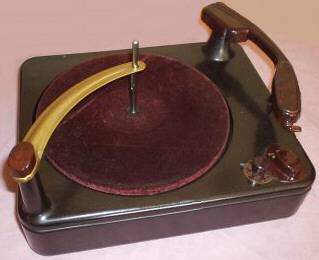
V-M 406 and 407 properties
It plays the following records automatically
12" and 10" 78 rpm records intermixed
12" and 10" 33 rpm records intermixed
7" 33 rpm records separately
7" 45 rpm records separately
The speed knob has these 4 positions.
First, we need to decide what the Ideal Record Changer is.
Let's start with what it isn't.
The page author had an experience at age 5 that made him wonder why record changers could not figure things out for themselves:
The page author wanted to play a kid's 78 version of Perry Como's "Round and Round." he got as a gift on a V-M 407 changer belonging to his grandfather (similar V-M 406 shown at right).
The author's father and grandfather got into a small discussion while trying to play it on this record changer:
(GF) "Turn the knob here! It's a 78!"
(F) "No, turn it here. It's a 7-inch record!"
(GF) "But that's 33!"
(F) "We'll turn it there, then turn it to 78 once the arm sets down!"
"PSSSSSSSSSSH!"
(F) "Something's wrong, it missed the edge of the record!"
(GF) "Try the 45 position."
"PSSSSSSSSSSH!"
(F) "It still missed. This record seems too small."
(GF) "Let me get a ruler."
.... .... .... ....
(F) "Turn it to 78. This is a 6-inch record. We'll have to play it manually!"
This caused the author to wonder (at age 5) why they don't make a record changer that is smart enough to be able to play all sizes and speeds of records automatically.
WHAT IS THE IDEAL RECORD CHANGER?

The V-M 406 is one of the worst
| DAM | SPD | SEP |
OSZ | TRP | SOF |
|---|---|---|---|---|---|
MAN | REP | SSP | ASP | TEN | CUE |
| MIX | SMX | RPD | 2SD | 2SC | RSQ |
| SSH | NFG | TNY | GVS | HOL | 44 |
This changer was not made under ideal conditions. Instead, it was V-M's first 3-speed changer, designed in a hurry to get something on the market to accommodate the new 7" and 45 rpm records.
| COLOR CODES |
| Completely does this |
|---|
Partially does this |
| Does this in some cases |
| Doesn't do or minimally does this |
Score % of ideal |
The following are properties of the Minimal Ideal Record Changer:
- [DAM] Does not damage records
- [SPD] Plays all record speeds sold
- [SEP] Separate each record from the others without error
- [OSZ] Automatically plays all sizes sold (including odd sizes) without error*
- [TRP] Automatically trips at the end of the record
- [SOF] Automatically turns off after the last record
- [MAN] Can play records manually when desired
- [REP] Can be set to correctly play the current record side again when it finishes*
- [SSP] Plays all record sizes provided at all speeds provided
- [ASP] Plays single record on turntable*
- [TEN] Can hold at least 10 records
- [CUE] Has a cue control to raise and lower the arm
The following are additional properties of the Totally Ideal Record Changer:
- [MIX] Takes all record sizes intermixed in the sequence of loaded records*
- [SMX] Plays large 33 rpm records and small 45 rpm records intermixed when desired*
- [RPD] Can take Audiotex record repeating discs to program repeats into the sequence*
The following are additional properties of the Ultimate Luxury Ideal Record Changer:
- [2SD] Plays both sides of the records when desired
- [2SC] Plays the drop, slide, manual, and relay side couplings when desired
- [RSQ] Can repeat the entire sequence over and over, indefinitely, or a set number of times, when desired.
The following exceptions simplify the problem of designing an ideal changer
- [SSH] Soundsheets (records thin enough to be in magazines) need not be played automatically
- [NFG] Records without finishing grooves need not be handled
- [TNY] Records as small as the repeating discs can be treated as repeating discs
- [GVS] Does not need to handle different groove sizes in the same sequence.
- [HOL] Does not need to handle different center hole sizes in the same sequence.
* - See the section WHY CAN'T WE REACH THE IDEAL?
See scoring section below.
WHY ARE THESE FEATURES NEEDED?
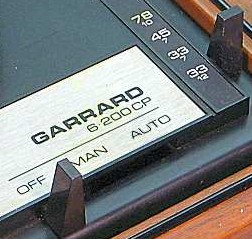
Garrard 6-200 - Not what we want
Minimal Ideal Record Changer:
- [DAM] Does not damage records - preserve the records
- [SPD] Plays all record speeds sold - play all available records
- [SEP] Separate each record from the others without error - not change two records at once
- [OSZ] Automatically plays all sizes sold (including odd sizes) without error - play all available records
- [TRP] Automatically trips at the end of the record - keep the sequence going
- [SOF] Automatically turns off after the last record - not repeating the last record endlessly
- [MAN] Can play records manually when desired - play just a portion of the record
- [REP] Can be set to play the current record side again when it finishes - hear the piece again
- [SSP] Plays all record sizes provided at all speeds provided - play all available records
- [ASP] Plays single record on turntable - Auto play without changing
- [TEN] Can hold at least 10 records - play many of the old albums
- [CUE] Has a cue control to raise and lower the arm - protect records
Totally Ideal Record Changer:
- [MIX] Takes all record sizes intermixed in the sequence of loaded records - play many old albums made with multiple sizes, play more records by artist
- [SMX] Plays large 33 rpm records and small 45 rpm records intermixed when desired - play most records by one artist together
- [RPD] Can take Audiotex record repeating discs to program repeats into the sequence - make a record repeat as part of the program
Ultimate Luxury Ideal Record Changer:
- [2SD] Plays both sides of the records when desired - play many old albums automatically
- [2SC] Plays the drop, slide, manual, and relay side couplings when desired - play all old albums made different ways
- [RSQ] Can repeat the entire sequence over and over, indefinitely, or a set number of times, when desired. - continuous music for a party
Exceptions - why they are not needed
- [SSH] Soundsheets (records thin enough to be in magazines) need not be played automatically - soundsheets are not normally changed
- [NFG] Records without finishing grooves need not be handled - difficult to do
- [TNY] Records as small as the repeating discs can be treated as repeating discs - hard to tell repeat discs from tiny records
- [GVS] Does not need to handle different groove sizes in the same sequence - normally requires a cartridge or stylus change anyway
- [HOL] Does not need to handle different center hole sizes in the same sequence. - can use center hole adapters instead
WHY ARE THESE SO HARD TO DO
The Minimal Ideal Record Changer:
- [DAM] Does not damage records - Depends on the care the device puts into handling the records
- [SPD] Plays all record speeds sold - Yellow = 4 speeds, green = continuously variable
- [SEP] Separate each record from the others without error - Hard when the thinnest record is 1/3 the thickness of the thickest record
- [OSZ] Automatically plays all sizes sold (including odd sizes) without error - Requires a sensor capable of detecting odd sizes
- [TRP] Automatically trips at the end of the record - different records have different finishing grooves (or none)
- [SOF] Automatically turns off after the last record - Needs to sense the absence of records
- [MAN] Can play records manually when desired - Needs a trip defeat (green) or manual start (yellow)
- [REP] Can be set to play the current record side again when it finishes - Needs ability to sense or remember the size of the record already playing
- [SSP] Plays all record sizes provided at all speeds provided - The size must not depend on the speed (cheap designs link them)
- [ASP] Plays single record on turntable - Must be able to find the correct size of the record already on the turntable
- [TEN] Can hold at least 10 records - Needs more space
- [CUE] Has a cue control to raise and lower the arm - Not difficult
The Totally Ideal Record Changer:
- [MIX] Takes all record sizes intermixed in the sequence of loaded records - Must sense the size of the record to play and ignore other records
- [SMX] Plays large 33 rpm records and small 45 rpm records intermixed - Uses record size to choose speed when selected (green) or always (yellow)
- [RPD] Can take Audiotex record repeating discs to program repeats into the sequence - On drop changers, can play the same record again
The Ultimate Luxury Ideal Record Changer:
- [2SD] Plays both sides of the records when desired - Extremely difficult (Drop changer can do with two copies of the album)
- [2SC] Plays the drop, slide, manual, and relay side couplings when desired - Even more difficult (Drop changer can do with two copies of the album)
- [RSQ] Can repeat the entire sequence over and over, indefinitely, or a set number of times, when desired. - Very difficult
The exceptions
- [SSH] Soundsheets (records thin enough to be in magazines) need not be played automatically - Separating such thin records is very hard
- [NFG] Records without finishing grooves need not be handled - Not designed for record changers
- [TNY] Records as small as the repeating discs can be treated as repeating discs - Impossible to handle both
- [GVS] Does not need to handle different groove sizes in the same sequence - Normally requires a cartridge or stylus change anyway
- [HOL] Does not need to handle different center hole sizes in the same sequence - Much easier to use hole adapters
SCORING
| Start with 100 and add/subtract the following scores | ||||
|---|---|---|---|---|
| Item | Completely does this | Partially does this |
Does this in some cases | Doesn't or minimally does |
| Minimal Ideal Record Changer | ||||
| [DAM] Does not damage records | 0 Safe | -6 touch grooves, lost disc |
-10 Hole or rim damage |
-16 Hazard to records |
| [SPD] Speeds | 0 Variable Speeds | -2 Four speeds |
-4 Three speeds |
-6 One or two speeds |
| [SEP] Record separation | 0 Works with most records | -4 No 12" shellac |
-8 Other |
-12 No shellac records |
| [OSZ] Odd Sizes | 0 Sizes 6" to 12" | -2 Sizes 7" to 12" |
-4 Other |
-6 Three sizes |
| [TRP] Automatic trip | 0 Works with most records | -2 Some eccentric trip fail |
-4 Other |
-6 Requires one trip type |
| [SOF] Automatic Shutoff | 0 Works with most records | -2 Works with some sizes |
-4 Other |
-6 Repeats last record |
| [MAN] Manual operation | 0 Full trip defeat | -2 Manual start |
-4 - |
-6 No manual start |
| [REP] Repeat Playing Record | 0 Repeat playing record | -2 Repeat single record |
-4 Gets some sizes wrong |
-6 No repeat |
| [SSP] Sizes-speed combinations | 0 All sizes at all speeds | -2 - |
-4 Some speeds manual |
-6 No to some size-speed |
| [ASP] Auto Single Play | 0 Auto Single, any spindle | -2 Auto single, long spindle |
-4 Gets some sizes wrong |
-6 Must drop from spindle |
| [TEN] Holds ten records | 0 Holds 10 records | -2 Holds 8 records |
-4 Holds 6 records |
-6 Holds < 6 records |
| [CUE] Has cue control | 0 Has cue control | -2 - |
-4 Cue uses change cycle |
-6 No cue control |
| Totally Ideal Record Changer | ||||
| [MIX] Intermixed record sizes | 0 All sizes, random mix | -2 All sizes, arranged mix |
-3 Intermix two sizes |
-4 No intermix |
| [SMX] Intermixed record speeds | 0 Large 33, small 45 setting | -2 Large 33, small 45 always |
-3 - |
-4 No speed intermix |
| [RPD] Use Audiotex repeat discs | 0 Works for all records | -2 next record same size |
-3 Certain circumstances |
-4 No repeat disc use |
| Luxury Ideal Record Changer | ||||
| [2SD] Play both sides when desired | 4 Works for all records | 2 - |
1 Only some sizes work |
0 No 2-side use |
| [2SC] All side sequences | 4 Works all side orders | 2 Uses 2 or 3 side orders- |
1 Uses only 1 side order |
0 No 2-side use |
| [RSQ] Repeat entire sequence | 4 Repeats entire sequence | 2 Repeat stack top sides |
1 - |
0 Cannot repeat sequence |
| Exceptions | ||||
| [SSH] Soundsheets need not work | 4 Soundsheets work | 2 - |
1 - |
0 Soundsheets play manually |
| [NFG] No finishing groove | 4 Works anyway | 2 - |
1 - |
0 Does not trip (normal) |
| [TNY] Tiny record handling | 4 Plays as a record | 2 - |
1 - |
0 Treats as a repeating disc |
| [GVS] Groove size Handling | 4 Handled automatically | 2 Forced by speed setting- |
1 - |
0 Handled manually |
| [HOL] Hole size handling | 4 Handled automatically | 2 - |
1 - |
0 Use spider inserts |
| Sum up your final score here. | ||||
| Sum the scores below separately. | ||||
| Ultimate Luxury Ideal Record Changer | ||||
| [SMA] Manual side couplings | 4 Completely automatic | 2 Requires several turn-overs |
1 Record order wrong after |
0 No manual sequence |
| [SDR] Drop side couplings | 4 Completely automatic | 2 Requires turn over halfway |
1 - |
0 No drop sequence ¤ |
| [SSL] Slide side couplings | 4 Completely automatic | 2 Requires turn over halfway |
1 - |
0 No slide sequence ¤ |
| [SRY] Relay side couplings | 4 Completely automatic | 2 Requires turn over halfway |
1 - |
0 No relay sequence |
| ¤ Do not score a single-side changer here. | ||||
BEST POSSIBLE SCORES: |
||||
Minimal Ideal Changer: 88 |
Totally Ideal Changer: 100 |
Enhanced Ideal Changer: 124 |
Ultimate Luxury Changer: 132 |
Side Coupling Sequences: 16 |
SAMPLE RECORD CHANGERS
Perpetuum Ebner PE 2038 B (modified to add repeat)
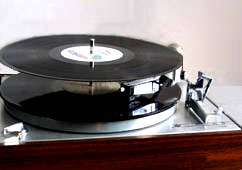
PE 2038 B - no intermix
DAM | SPD | SEP |
OSZ | TRP | SOF |
|---|---|---|---|---|---|
MAN | REP | SSP | ASP | TEN | CUE |
| MIX | SMX | RPD | 2SD | 2SC | RSQ |
| SSH | NFG | TNY | GVS | HOL | 70 |
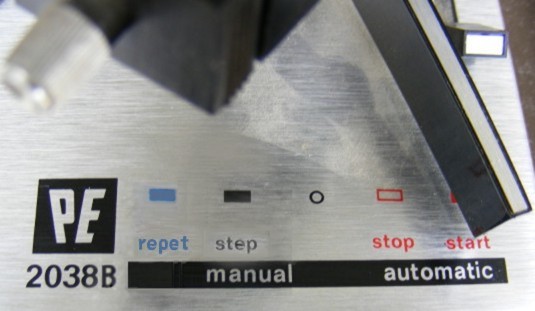
The following are properties of the PE 2038 B:
- [DAM] Umbrella spindle could have trouble with shellac records
- [SPD] Plays only 3 speeds (33, 45, 78)
- [SEP] Trouble with 12" 78 or very thin records
- [OSZ] Plays 3 sizes (7", 10", 12") automatically sensed
- [MAN] The STEP position provides manual start (no trip defeat)
- [REP] REPET position plays same record side again when it ends
- [ASP] Plays single record on turntable with single play spindle
- [CUE] Has cue control
- [MIX] Cannot intermix sizes
- [RPD] Modified to take Audiotex record repeating discs
- [HOL] Uses adapters for large hole records
- Any number of repeating discs can follow any record.
- The START and STOP positions start change cycles.
- The STEP, REPET, and O positions wait for the record to end
- Move the command lever to STEP, then to O, to start the turntable.
- No record drops when the command lever is in the STEP, STOP, or REPET position.
- Feelers rise in the turntable and beside it to feel the size of the first record.
- The arm cannot set down on an empty turntable.
Not bad for the Minimal Ideal Record Changer.
Perpetuum Ebner PE Rex AA
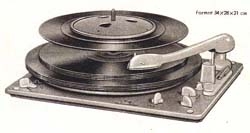
PE Rex AA - no repeat
DAM | SPD | SEP | OSZ | TRP | SOF |
|---|---|---|---|---|---|
MAN | REP | SSP | ASP | TEN | CUE |
| MIX | SMX | RPD | 2SD | 2SC | RSQ |
| SSH | NFG | TNY | GVS | HOL | 64 |
The following are properties of the PE Rex AA:
- [DAM] Step-drop could harm very heavy records
- [SPD] Plays 4 speeds (16, 33, 45, 78)
- [OSZ] Plays sizes from 12" to 6" automatically sensed
- [MAN] Lifting the arm starts the turntable (no trip defeat)
- [REP] No repeat function
- [ASP] Does not index single record on turntable, has single play spindle
- [CUE] No cue control
- [MIX] Can intermix all sizes of the same speed in any order
- [RPD] Audiotex repeating discs make the changer shut off
- [HOL] Uses adapters for large hole records
- The START button near the rest post starts the change cycle.
- The other controls at right front are for the pickup cartridge mode.
- The spindle drops the record about half an inch so the feeler can feel the size.
- The feeler on the left side of the pickup arm tip feels the size of the separated record.
- The weight of the lowered record tells the changer a record is there.
- The arm cannot set down on an empty turntable.
Not quite the ideal.
Collaro TSC-640/1019A (modified for autospeed)
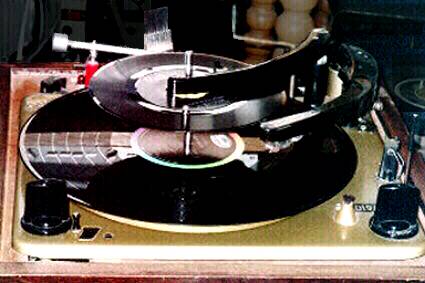
Collaro TSC640/1019A - half and half
| DAM | SPD | SEP | OSZ | TRP | SOF |
|---|---|---|---|---|---|
| MAN | REP | SSP | ASP | TEN | CUE |
MIX | SMX | RPD |
2SD | 2SC | RSQ |
| SSH | NFG | TNY | GVS | HOL | 82 |
The following are properties of the Collaro TSC640/1019A:
- [DAM] Very gentle. Stops turntable during change cycle.
- [SPD] Plays 4 speeds (16, 33, 45, 78)
- [SEP] The spindle feels the thickness of the record.
- [OSZ] Plays sizes from 12" to 6" automatically sensed
- [MAN] PLAY control is manual start. Holding it is trip defeat.
- [REP] No repeat function
- [ASP] Does not index single record on turntable, spindle is not removable
- [CUE] Cue control was added
- [MIX] Can intermix all sizes of the same speed when arranged in order largest to smallest
- [SMX] Can play large 33 rpm followed by small 45 rpm
- [RPD] Audiotex repeating discs work if another record the same size is next
- [HOL] Uses adapters for large hole records
- The Automatic control at right front starts the change cycle.
- The feeler on the left side of the pickup arm tip feels the size of the unplayed stack.
- If the arm finds no record, automatic shutoff occurs.
- The arm cannot set down on an empty turntable.
Not quite the ideal, but much better. This is the page author's favorite record changer.
Luxor RTW-7
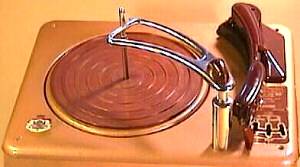
Luxor RTW-7
DAM | SPD | SEP | OSZ | TRP | SOF |
|---|---|---|---|---|---|
| MAN | REP | SSP | ASP | TEN | CUE |
| MIX | SMX | RPD | 2SD | 2SC | RSQ |
| SSH | NFG | TNY | GVS | HOL | 74 |
The following are properties of the LUXOR RTW-7:
- [DAM] Feeler wheel touches record grooves
- [SPD] Plays 4 speeds (16, 33, 45, 78)
- [OSZ] Plays sizes from 12" to 6" automatically sensed
- [MAN] Manual is trip defeat. Raise overarm and swing out to defeat trip
- [REP] No repeat function
- [ASP] Can index single record on turntable, no single play spindle
- [CUE] No cue control
- [MIX] Can intermix all sizes of the same speed in any order
- [RPD] Audiotex repeating discs work
- [NFG] Records without finishing grooves still trip the progress trip
- [GVS] Automatically changes groove size with speed.
- [HOL] Uses adapters for large hole records
- The single knob sets speed and Manual, Off, Auto, and Reject.
- The feeler wheel in the pickup arm tip feels the size of the top record on the turntable.
- Luxor named this feeler wheel the "Rolling Pickup".
Not quite the ideal, but very close.
DUAL 1006A
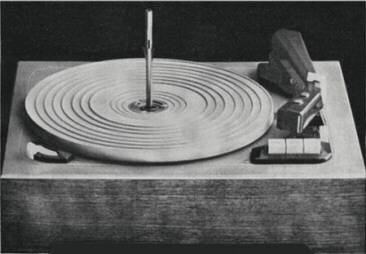
Dual 1006A
DAM | SPD | SEP | OSZ | TRP | SOF |
|---|---|---|---|---|---|
MAN | REP | SSP | ASP | TEN | CUE |
| MIX | SMX | RPD | 2SD | 2SC | RSQ |
| SSH | NFG | TNY | GVS | HOL | 80 |
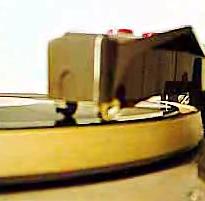
The following are properties of the Dual 1006A:
- [DAM] Feeler wheels touch record grooves
- [SPD] Plays 4 speeds (16, 33, 45, 78)
- [OSZ] Plays sizes from 12" to 6" automatically sensed
- [MAN] MANUAL is just manual start
- [REP] REPET button repeats playing record side again when it ends
- [ASP] Can index single record on turntable with short spindle
- [CUE] No cue control
- [MIX] Can intermix all sizes of the same speed in any order
- [RPD] Audiotex repeating discs work
- [HOL] Uses adapters for large hole records
- The START and STOP buttons start change cycles.
- The REPET and MANUAL positions wait for the record to end
- Use the MAN button to start the turntable.
- No record drops when the REPET button is down.
- Press REPET, then STOP, to stop the changer without dropping the next record.
- The feeler wheels in the pickup arm tip feel the size of the top record on the turntable.
- Very few of these still work because the rubber parts (including the feeler wheels) rotted away.
Not quite the ideal, but even closer.
WHY CAN'T WE REACH THE IDEAL?
The main reason the ideal has not been reached is that the methods needed for intermixed record sizes are different from the methods needed to repeat an already played record.
- For a random intermix of record sizes, the record is usually felt while it is dropping down the spindle or while the record is separated from the other records.
- For an arranged intermix of record sizes, the record is usually felt while it is in the stack of records yet to be played.
- For a record to be repeated, either the record must be felt again the second time it is played, or the setdown index must remember the size from the previous play.
The problem is that the method for feeling a record for intermixed sizes is not normally the method needed for repeating a record. The record to be repeated is not usually in the same place that it was in when it was originally felt for size intermix.
| SIZE SENSING | SIZE RANGE | INITIAL SENSE LOCATION | REPEAT SENSE LOCATION | PROBLEM RESOLUTION |
|---|---|---|---|---|
| Turntable sensor | 7", 10", 12" | On turntable | On turntable | No size intermix |
| Falling record sensor | 7", 10", 12" | Falling down spindle (random mix) | On turntable | No repeat |
| Falling record sensor | 7", 10", 12" | Falling down spindle (random mix) | On turntable | Repeat size control |
| Falling record sensor | 7", 10", 12" | Falling down spindle (random mix) | On turntable (saved) | Repeat button saves size |
| Stack record sensor | 7", 10", 12" | On stack (arranged mix) | On turntable | No repeat |
| Stack record sensor | 7", 10", 12" | On stack (arranged mix) | On turntable | Repeat disc, same size on stack |
| Stack record sensor | 7", 10", 12" | On stack (arranged mix) | On turntable (saved) | Repeat button saves size |
| Stack record sensor | 6" to 12" | On stack (arranged mix) | On turntable | Repeat disc, same size on stack |
| Stack record sensor | 6" to 12" | On stack (arranged mix) | On turntable (saved) | Repeat button saves size |
| Lowered record sensor | 6" to 12" | Partway down spindle (random mix) | On turntable | No repeat |
| Lowered record sensor | 6" to 12" | Partway down spindle (random mix) | On turntable (saved) | Repeat button saves size |
| Feeler wheel sensor | 6" to 12" | Top record on turntable (random mix) | Top record on turntable | Repeat disc |
| Feeler wheel sensor | 6" to 12" | Top record on turntable (random mix) | Top record on turntable | Repeat button |
| Record alone on turntable | 4" to 12" | Only record on turntable (random mix) | Only record on turntable | Repeat button |
At first glance the feeler wheel seems the ideal solution. But the wheel touches the grooves and might contaminate them if not kept clean.
HOW COULD WE REACH THE IDEAL?
Actually, it can be done. But it would be expensive. Here are several methods:
- Some kind of electronic sensor finds the edge of the top record without touching it.
- Some kind of pneumatic sensor finds the edge of the top record without touching it.
- Lift the top record off the turntable to feel it again with the arm tip.
- Only one record on the turntable at a time.
- The Fisher Lincoln solution below.
The rest of this page is the result of pure imagination....
Except that all but two of the following record changers actually exist.
PART 2: ACHIEVING THE ULTIMATE LUXURY IDEAL
NOW WE ENTER THE REALM OF FANTASY. FEW COULD AFFORD TO BUY THESE.
Histories of Side Coupling Sequences
- Manual Sequence was used before record
changers existed.
- Drop Sequence has been used ever since drop
changers appeared.
- Relay Sequence is usually limited to DJ copies.
- Slide sequence was used with 78s from 1931 to
1945 while throwoff changers were being made.
Oddities:
- Slide Sequence 45s were made when no Slide
45 players existed.
- Thorens TD-224 plays Slide Sequence, not Drop.
- Fisher Lincoln 70 plays Slide and Manual, not Drop.
- The page author has a Drop album misnumbered
as a Slide album.
- A professional record critic once reviewed the blank
sides of a DJ copy of the Beatles album "Beatles 1".
It was pressed in the Relay Sequence for DJ use.
Reviewers aren't normally given DJ copies, so he
didn't know what he had.
In additions to the capabilities of the Ideal Record Changer, the Ultimate Luxury Ideal Record Changer can also play a complete record album without the user having to restack or reorder the records somewhere in the middle. The changer can also repeat the sequence over and over.
The following are the four side coupling sequences that have been used in record albums:
- The Manual Sequence was the first to be used. The sides are coupled so someone playing the album manually can easily find the next side.
- The Drop Automatic Sequence was designed for changers that drop records down a spindle. The stack is turned over and put back on the spindle halfway through the album. Drop changers do not reverse the stack as they go through it.
- The Slide Automatic Sequence was designed for changers that take records off the turntable and place them to the side. The stack is turned over and put back on the turntable halfway through the album. Slide changers do reverse the stack as they go through it.
- The Relay Sequence was designed for DJs so the next record is always available to
be cued up on the other turntable. The records are not placed in a stack. The records
are always made in groups of four sides (two records). Any extra sides at the end
of a relay sequence have quick runoff blank grooves.
- DJs prefer the Slide and Relay sequences because the next record is always available to be cued up on the other turntable.
The changer must also be able to take a normal one-sided stack.
The changer must also be able to take a single record for manual play.
The changer must also work with albums made of several 12" records and one 10" or 7" record placed last. A few such albums were made.
The table below shows the playing orders of each of the side couplings for 5-record albums. The light red spaces in the table below are states where the next side to be played is on the back of the record being played.
| SIDE COUPLING SEQUENCES | ||||||||||||
|---|---|---|---|---|---|---|---|---|---|---|---|---|
| COUPLINGS | 1 | 2 | 3 | 4 | 5 | 6 | 7 | 8 | 9 | 10 | ||
| Manual Sequence | 1/2. 3/4, 5/6. 7/8, 9/10 | 1/2 | 2/1 | 3/4 | 4/3 | 5/6 | 6/5 | 7/8 | 8/7 | 9/10 | 10/9 | |
| Drop Sequence | 1/10. 2/9, 3/8. 4/7, 5/6 | 1/10 | 2/9 | 3/8 | 4/7 | 5/6 | 6/5 | 7/4 | 8/3 | 9/2 | 10/1 | |
| Slide Sequence | 1/6. 2/7, 3/8, 4/9, 5/10 | 1/6 | 2/7 | 3/8 | 4/9 | 5/10 | 6/1 | 7/2 | 8/3 | 9/4 | 10/5 | |
| Relay Sequence | 1/3. 2/4, 5/7. 6/8, 9/11, 10/12 | 1/3 | 2/4 | 3/1 | 4/2 | 5/7 | 6/8 | 7/5 | 8/6 | 9/11 | 10/12 | |
Sides 11 and 12 of the 10-side relay sequence album have quick runoff grooves. They are not played.
Anyone who does not own the correct record changer to play a multiple record album can buy two copies of the album and use a drop changer. The records from the second copy are shown in blue.
| BUYING TWO ALBUMS TO PLAY ENTIRE ALBUM WITHOUT A BREAK | ||||||||||||
|---|---|---|---|---|---|---|---|---|---|---|---|---|
| COUPLINGS | 1 | 2 | 3 | 4 | 5 | 6 | 7 | 8 | 9 | 10 | ||
| Manual Sequence | 1/2. 3/4, 5/6. 7/8, 9/10 | 1/2 | 2/1 | 3/4 | 4/3 | 5/6 | 6/5 | 7/8 | 8/7 | 9/10 | 10/9 | |
| Drop Sequence | 1/10. 2/9, 3/8. 4/7, 5/6 | 1/10 | 2/9 | 3/8 | 4/7 | 5/6 | 6/5 | 7/4 | 8/3 | 9/2 | 10/1 | |
| Slide Sequence | 1/6. 2/7, 3/8, 4/9, 5/10 | 1/6 | 2/7 | 3/8 | 4/9 | 5/10 | 6/1 | 7/2 | 8/3 | 9/4 | 10/5 | |
| Relay Sequence | 1/3. 2/4, 5/7. 6/8, 9/11, 10/12 | 1/3 | 2/4 | 3/1 | 4/2 | 5/7 | 6/8 | 7/5 | 8/6 | 9/11 | 10/12 | |
Notice that the stack for the drop sequence can be turned over and it will play the album again correctly.
Sides 11 and 12 of the 10-side relay sequence album have quick runoff grooves. They do not need to be played.
Here is a table of how much work needs to be done to play a single album of the wrong side sequence on various kinds of changers:
| PLAY ONE ENTIRE ALBUM IN ORDER | |||||||
|---|---|---|---|---|---|---|---|
| ALBUM \\ CHANGER TYPE | MANUAL | LD | DROP | LD | SLIDE | LD | 2 DJ PLAYERS |
| PLAY TOP SIDES | Use ONE SIDE mode | 1 | Load in wanted order | 1 | Load in wanted order | 1 | Next side on other player f |
| MANUAL SEQ ALBUM | Use TWO SIDE mode | 1 | Stacks of two records d | n/2+1 | Stacks of two records d | n/2+1 | Each disc must turn over g |
| DROP SEQ ALBUM | (See 1-side mode col a) | > > > | Turn over halfway b | 2 | Invert & restack halfway c | 2 | One disc must turn over h |
| SLIDE SEQ ALBUM | (See 1-side mode col a) | > > > | Invert & restack halfway c | 2 | Turn over halfway b | 2 | Next side on other player f |
| RELAY SEQ ALBUM | (See 1-side mode col a) | > > > | Stacks of four records e | n/4+1 | Stacks of four records e | n/4+1 | Next side on other player f |
n = Number of sides in album (for Relay Seq, must be multiple of 4)
LD = number of times the changer is loaded.
a Use the table column for the kind of one-side play the changer
can play (drop or slide).
b When the changer shuts off halfway through the album, turn the
stack over, load it, and restart the changer.
c When the changer shuts off halfway through the album, turn the
stack over and hold it, move the records one at a time to the changer, and then restart
the changer.
d One side (odd) played alone, followed by stacks of two records
(next even and next odd), followed by the final side
e Two sides in a stack, followed by stacks of four records
(next odd, even, odd, and even), followed by the final two sides
f The next side can always be cued up on the other turntable.
g The next even side is always on the back of the playing odd side.
Each record must be turned over and played before the next record is played.
h The next side can be cued up on the other turntable, except the
middle record, which must be turned over to get the next side.
Specifications for the Ultimate Luxury Ideal changer:
- The two-side modes must work for all record sizes. The page author has three albums of 45s in slide-automatic sequence.
- The repeat function repeats the current side.
- Note in the example changers below that all drop changers play only half of the drop sequence. Then the stack must be turned over by hand.
- Some multi-disc albums were made with mixed sizes. The small sizes were always played last.
SAMPLE RECORD CHANGERS CLOSE TO THE ULTIMATE LUXURY IDEAL
Markel 74 Playmaster
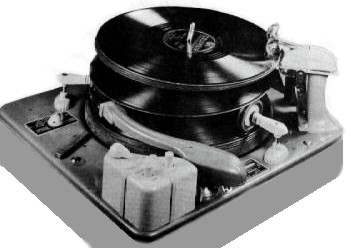
Markel 74
DAM | SPD | SEP | OSZ | TRP | SOF |
|---|---|---|---|---|---|
| MAN | REP | SSP | ASP | TEN | CUE |
| MIX | SMX | RPD | 2SD | 2SC | RSQ |
| SSH | NFG | TNY | GVS | HOL | 49 |
| SMA | SDR |
SSL | SRY | 6 | |
The following are properties of the Markel 74:
- [DAM] Rotation reversing wheels touch record grooves
- [SPD] Plays 3 speeds (33, 45, 78)
- [OSZ] Plays both sides of 10" & 12" records, one side of 7"
- [MAN] Manual is full manual
- [REP] No record repeat
- [ASP] No single record play, no short spindle
- [MIX] Can not intermix sizes
- [RPD] Repeating discs can jam changer
- [2SD] Plays both sides of 10" & 12" records when desired
- [2SC] Plays the manual sequence, and plays half of the drop sequence
- [HOL] Uses adapters for large hole records
- [SMA] Plays the entire Manual Sequence
- [SDR] Plays half of the Drop Sequence
- [SSL] Plays half of the Slide Sequence if records are restacked when turned over
- [SRY] Does not play the Relay Sequence
- The ON button starts the change cycle.
- The OFF button turns off power.
- Press the ON button halfway down to start the turntable.
- Drops record onto wheels to play undeside, then removes wheels to play top side.
- Leaves arm in finishing groove of last record when it turns off. Simplifies unloading.
Barely meets the category
Fisher Lincoln 70
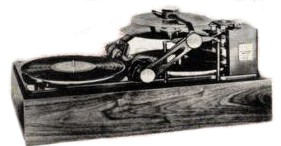
Fisher Lincoln 70
DAM | SPD | SEP | OSZ | TRP | SOF |
|---|---|---|---|---|---|
| MAN | REP | SSP | ASP | TEN | CUE |
| MIX | SMX | RPD | 2SD | 2SC | RSQ |
SSH | NFG | TNY | GVS | HOL | 74 |
SMA | SDR | SSL | SRY | 3 | |
The following are properties of the Fisher Lincoln 70:
- [DAM] Could damage record by letting go of it if vacuum cup is dirty
- [SPD] Plays 3 speeds (33, 45, 78)
- [SEP] Vacuum record changing ignores record thickness.
- [OSZ] Plays both sides of records 4" to 12"
- [MAN] No manual operation
- [REP] No record repeat
- [ASP] No single record play, no short spindle
- [MIX] Can randomly intermix sizes 4" to 12"
- [SMX] Can randomly intermix large 33 rpm and small 45 rpm
- [RPD] Wrongly tries to play repeating discs
- [2SD] Plays both sides of records when desired
- [2SC] Plays the manual sequence, and plays half of the slide sequence
- [SSH] Soundsheets work if they are stiff enough to be indexed.
- [NFG] Records without finishing grooves don't trip
- [TNY] Records as small as repeating discs are treated as records
- [GVS] Does not need to handle different groove sizes in the same sequence.
- [HOL] Uses adapters for large hole records
- [SMA] Plays the entire Manual Sequence, but reverses the stack in the process
- [SDR] Plays half of the Drop Sequence if records are restacked when turned over
- [SSL] Plays half of the Slide Sequence
- [SRY] Does not play the Relay Sequence
- The START button starts the change cycle.
- The OFF button turns off power.
- Reverses the stack as it plays it.
Slightly better
Other contenders:
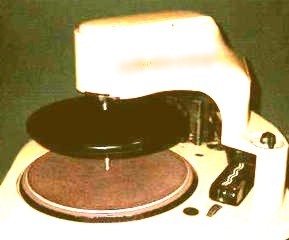
Thorens CD-50
| DAM | SPD | SEP | OSZ | TRP | SOF |
|---|---|---|---|---|---|
| MAN | REP | SSP | ASP | TEN | CUE |
| MIX | SMX | RPD | 2SD | 2SC | RSQ |
| SSH | NFG | TNY | GVS | HOL | 62 |
| SMA | SDR |
SSL | SRY | 6 | |
The spindle is split. The top half and
turntable rotate in opposite directions.
The black disk is a turntable turning
with the top spindle half.
| CHANGER MODEL | SPEEDS | RECORD SIZES | TWO SIDES | RECORD SEQUENCES | STACK REPEAT |
|---|---|---|---|---|---|
| Capehart Turnover | 78 | 12" & 10" | YES | Slide and Manual | YES |
| Capehart Turnover | 33, 78 | 12" & 10" | YES | Slide and Manual | YES |
| Fisher Lincoln 60 and 70 | 16, 33, 45, 78 | 12" to 4" | YES | Slide † and Manual ♦ | NO |
| Garrard RC-100 ♥ | 33, 78 | 12" & 10" | YES | Drop † and Manual ♦ | NO |
| Lincoln 30 and 50 | 33, 45, 78 | 12" to 4" | YES | Drop † and Manual | NO |
| Markel 70 Playmaster | 78 | 12" & 10" | YES | Drop † and Manual | NO |
| Markel 74 Playmaster | 33, 45, 78 | 12", 10", & 7" ‡ | YES | Drop † and Manual | NO |
| RCA Duo; | 33, 78 | 12" & 10" | NO | Slide † | NO |
| RCA Magic Brain V-225 ♥ | 78 | 12" & 10" | YES | Drop † and Manual | NO |
| Risteaucrat 45 | 45 | 7" | NO | Drop † | YES |
| Risteaucrat 400 | 45 | 7" | YES | Drop † and Manual | YES |
| Thorens CD-50 | 78 | 12" & 10" | YES | Drop † and Manual | NO |
| Thorens CD-53 | 33, 45, 78 | 12", 10", & 7" | YES | Drop † and Manual | NO |
| Thorens TD-224 | 16, 33, 45, 78 | 12" to 4" | NO | Slide † | NO |
| Victor Auto Change 2 | 78 | 10" | YES | Slide † and Manual ♦ | NO |
† = Plays half of the sequence. Requires manually inverting the stack to finish the album.
‡ = 7" records must be played one side.
♦ = Records are left in reversed order useless to the sequence.
♥ = Very few were made because World War II halted production.
All of these still fall short.
HOW COULD WE REACH THE ULTIMATE LUXURY IDEAL?
Actually, it can be done. But it would be very expensive. Here are several methods:
- Records shuttle back and forth between two piles with a two-side turntable (Like Fisher Lincoln)
- Records are moved up and down on a long spindle (similar to Thorens CD-50)
- A device like a jukebox that takes any record size in each pocket
- Two identical two-side systems so one can get the next record into place while the other
is playing
(still has delays in Drop and Manual sequences)
ONE WAY TO ACHIEVE THE ULTIMATE LUXURY IDEAL?
Modifying a Fisher Lincoln 70:
The following changes must be made to the Fisher Lincoln 70:
- The pneumatic control system must be removed. Solenoid valves must be used to send compressed air to the existing controls from a new electric control system.
- The turntable unit and the record platforms must be modified so the turntable can pick up records and drop off records at either platform.
- The control system must be able to handle manual operation with the turntable at the top, one-side operation, manual sequence, drop sequence, slide sequence, and relay sequence.
- The control system must also be able to handle record repeat and stack repeat.
Disclaimer: This is just a suggestion of how to do this.
The page author does not own or have access to a Fisher Lincoln record changer, so he has no idea how difficult any of these modifications really are.
Note that getting replacement rubber parts for a Fisher Lincoln will be very difficult.
Sample control panel:
| MANUAL PLAY |
TOP SIDES |
MANUAL SEQ |
DROP SEQ |
SLIDE SEQ |
RELAY SEQ |
TOP BOT |
|---|---|---|---|---|---|---|
| UNLOAD STACK |
REPEAT STACK |
REPEAT 1 SIDE |
STEP ON |
STOP REJECT |
START REJECT |
DIR <−> |
| <<−− CUE |
<− CUE |
LIFT CUE |
PLAY CUE |
−> CUE |
−−>> CUE |
CYC ON |
Modified Fisher Lincoln 70

Modified Fisher Lincoln 70
DAM | SPD | SEP | OSZ | TRP | SOF |
|---|---|---|---|---|---|
| MAN | REP | SSP | ASP | TEN | CUE |
| MIX | SMX | RPD | 2SD | 2SC | RSQ |
SSH | NFG | TNY | GVS | HOL | 108 |
| SMA | SDR | SSL | SRY | 16 | |
The following are properties of the Modified Fisher Lincoln 70:
- [DAM] Could damage record by letting go of it if vacuum cup is dirty
- [SPD] Plays any speeds 4 rpm to 120 rpm
- [SEP] Vacuum record changing ignores record thickness.
- [OSZ] Plays both sides of records 4" to 12"
- [MAN] Leaves turntable accessible at top when inactive
- [REP] Repeat control added to repeat the currently playing side
- [ASP] No single record play, has short spindle
- [MIX] Can randomly intermix sizes 4" to 12"
- [SMX] Can randomly intermix large 33 rpm and small 45 rpm
- [RPD] Wrongly tries to play repeating discs
- [2SD] Plays both sides of records when desired
- [2SC] Plays the drop, slide, manual, and relay side couplings when desired
- [SSH] Soundsheets work if they are stiff enough to be indexed.
- [NFG] Records without finishing grooves don't trip
- [TNY] Records as small as repeating discs are treated as records
- [GVS] Does not need to handle different groove sizes in the same sequence.
- [HOL] Uses adapters for large hole records
- [SMA] Plays the entire Manual Sequence correctly
- [SDR] Plays the entire Drop Sequence correctly
- [SSL] Plays the entire Slide Sequence correctly
- [SRY] Plays the entire Relay Sequence correctly
- The START button starts the change cycle for the selected sequence. It also rejects the playing side.
- The STOP button removes the arm from the record and puts it on its rest.
- The START button resumes operation with the side that was playing when STOP was pressed.
- When it finishes playing the stack, it returns the stack to the original platform in the original order.
- The changer can be set to repeat the entire sequence until stopped.
This does almost everything
| MODIFIED FISHER LINCOLN 70 PLAYING SEQUENCES | |||||||||||||||||||||
|---|---|---|---|---|---|---|---|---|---|---|---|---|---|---|---|---|---|---|---|---|---|
| 70 | top/bot bot\top | RECORD LOCATION | STAGE NUMBER: Direction, Record #, Side | ||||||||||||||||||
| SEQUENCE | Top | 2 | 3 | 4 | 5 | Bot | 1 | 2 | 3 | 4 | 5 | 6 | 7 | 8 | 9 | 10 | 11 | 12 | END | ||
| Top Sides | 1/ | 2/ | 3/ | 4/ | 5/ | >1T | >2T | >3T | >4T | >5T | << | ||||||||||
| Manual Sequence | 1/2 | 3/4 | 5/6 | 7/8 | 9/10 | >1T | F1B | >2T | F2B | >3T | F3B | >4T | F4B | >5T | F5B | << | |||||
| Drop Sequence | 1/10 | 2/9 | 3/8 | 4/7 | 5/6 | >1T | >2T | >3T | >4T | >5T | F5B | <4B | <3B | <2B | <1B | << | |||||
| Slide Sequence | 1/6 | 2/7 | 3/8 | 4/9 | 5/10 | >1T | >2T | >3T | >4T | >5T | <<>1B | >2B | >3B | >4B | >5B | << | |||||
| Relay Sequence | 1/3 | 2/4 | 5/7 | 6/8 | 9/11 | 10/12 | >1T | >2T | <1B | >2B | >3T | >4T | <3B | >4B | >5T | >6T | <5B* | >6B* | << | ||
| Key: | * = Side with quick runoff groove | > = Put record on right, get from left | << = Move all records to the left platform | <<> = Move all records left, then get record from left | |||||||||||||||||
| number = Record number on turntable | < = Put record on left, get from right | T = Play top side of record | B = Play bottom side of record | F = Turn record over | |||||||||||||||||
Notes:
- The first sides of all sequences are face up on top of the stack.
- With the top-sides and drop sequences the stack order is reversed to the order a
drop changer uses.
- The changer will play the unused sides of the relay sequence 10-side album at the end.
- If the relay sequence finds an odd number of records, both sides of the last record
play together.
ANOTHER WAY TO ACHIEVE THE ULTIMATE LUXURY IDEAL?
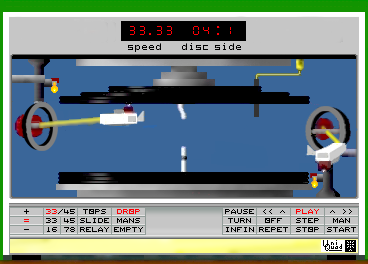 If the Uni-Quad Autosides design were ever built:
If the Uni-Quad Autosides design were ever built:
The following are design elements of the Uni-Quad Autosides:
- Two turntables and two arms are used, one set for playing the top sides and one set for playing the bottom sides.
- The spindles and record raiser (in lower turntable) are designed so they can drop one record, raise one record, raise two records, or raise the entire stack.
- Both arms scan for record size on the top turntable. Small records must be placed above large records.
- The control system allows manual operation with power cue for either turntable.
- The control system handles record repeat and stack repeat.
- The control system handles top sides, and two side operation for the manual, drop, slide, and relay sequences.
Disclaimer: This is just a suggestion of how to do this.
The page author has only sketched out this idea.
The mechanical arm control devices are based on the Collaro Conquest mechanism design.
The control panel is slanted and sticks out in front of the turntables. See it in the image at right:
Uni-Quad Autosides

Uni-Quad Autosides
| DAM | SPD | SEP | OSZ | TRP | SOF |
|---|---|---|---|---|---|
| MAN | REP | SSP | ASP | TEN | CUE |
MIX | SMX | RPD |
2SD | 2SC | RSQ |
| SSH | NFG | TNY | GVS | HOL | 108 |
| SMA | SDR | SSL | SRY | 16 | |
The following are properties of the Uni-Quad Autosides:
- [SPD] Plays any speeds 3 rpm to 120 rpm
- [OSZ] Plays both sides of records 5" to 12"
- [SEP] The spindle feels the thickness of the record.
- [MAN] Turns off automatic trip and starts current turntable. Second press turns trip on.
- [REP] Repeat control repeats the currently playing side when it ends
- [ASP] Single record play, has short spindle
- [MIX] Can intermix all sizes of the same speed when arranged in order largest to smallest
- [SMX] Can intermix large 33 rpm and small 45 rpm when arranged in order largest to smallest
- [RPD] Repeating discs work right only in Top Sides with no size intermix - other sequences do strange things
- [2SD] Plays both sides of records when desired
- [2SC] Plays the drop, slide, manual, and relay side couplings when desired
- [SSH] Soundsheets must be played manually
- [NFG] Records without finishing grooves don't trip
- [TNY] Records as small as repeating discs are treated as repeating discs
- [GVS] Does not need to handle different groove sizes in the same sequence
- [HOL] Uses adapters for large hole records
- [SMA] Plays the entire Manual Sequence correctly
- [SDR] Plays the entire Drop Sequence correctly
- [SSL] Plays the entire Slide Sequence correctly
- [SRY] Plays the entire Relay Sequence correctly
- The START button starts the change cycle for the selected sequence. It also rejects the playing side.
- The STOP button removes the arm from the record and puts it on its rest.
- The START button resumes operation with the side that was playing when STOP was pressed.
- When it finishes playing the stack, it returns the stack to the bottom turntable in the original order.
- The EMPTY button puts the arms on the rests, puts the stack on the bottom turntable, and clears the sequence memory.
- The INFIN button sets it to repeat the entire sequence until stopped.
This does almost everything
| UNI-QUAD AUTOSIDES PLAYING SEQUENCES | |||||||||||||||||||||||
|---|---|---|---|---|---|---|---|---|---|---|---|---|---|---|---|---|---|---|---|---|---|---|---|
| UQ | top/bot bot\top | RECORD LOCATION | STAGE NUMBER: Direction, Record #, Side | ||||||||||||||||||||
| SEQUENCE | Top | 5 | 4 | 3 | 2 | Bot | GO | 1 | 2 | 3 | 4 | 5 | 6 | MID | 7 | 8 | 9 | 10 | 11 | 12 | END | ||
| Top Sides | 5/ | 4/ | 3/ | 2/ | 1/ | ∩ | 1T | 2T | 3T | 4T | 5T | ⇓ | ∪ | ||||||||||
| Manual Sequence | 9/10 | 7/8 | 5\6 | 3\4 | 1\2 | ∩ | 1B | 1T | 2B | 2T | 3B | 3T | 4B | 4T | 5B | 5T | ⇓∪ | ||||||
| Drop Sequence | 5/6 | 4/7 | 3/8 | 2/9 | 1/10 | ∩ | 1T | 2T | 3T | 4T | 5T | ⇓ | ∧5B | ∧4B | ∧3B | ∧2B | ∧1B | ⇑∪ | |||||
| Slide Sequence | 5\10 | 4\9 | 3\8 | 2\7 | 1\6 | ⇓∩ | 1B | ∨2B | ∨3B | ∨4B | ∨5B | ⇓∩ | 1T | 2T | 3T | 4T | 5T | ⇓∪ | |||||
| Relay Sequence | 10/12 | 9\11 | 6\8 | 5\7 | 2\4 | 1\3 | ⇓∩ | 1B | ∨2B | Δ1T | 2T | 3B | ∨4B | Δ3T | 4T | 5B | ∨6B | Δ5T* | 6T* | ⇓∪ | |||
| Key: | * = Side with quick runoff groove | ⇓ = Empty top found | ∧ = Raise one record | ∩ = Raise all records | ∨ = Drop one record | ∪ = Lower all records | |||||||||||||||||
| number = Record # being played | ⇑ = Empty bottom found | Δ Raise two records | T = Scan, drop, and play top side of record | B = Scan and play bottom side of record | |||||||||||||||||||
Notes:
- The stack is arranged as it would be if the sequence were played on its own kind of
changer.
- With the top-sides and drop sequence, side 1 is the top side of the bottom record in
the stack, as on a Collaro Conquest.
- With the slide and relay sequence, side 1 starts as the top side of the top record in
the stack, as on a Fisher Lincoln, but then the stack is turned over before loading.
- With the manual sequence, side 1 is the bottom side of the bottom record in
the stack, as on a Markel Playmaster.
- The stack is always placed on the lower turntable when loading.
- The MID column in the list is the point where the changer starts playing the other
sides.
- If the MID box is gray, there is no midpoint where the changer changes its operation.
- The changer will play the unused sides of the relay sequence 10-side album at the end.
- If the relay sequence finds an odd number of records, both sides of the last record
play together.